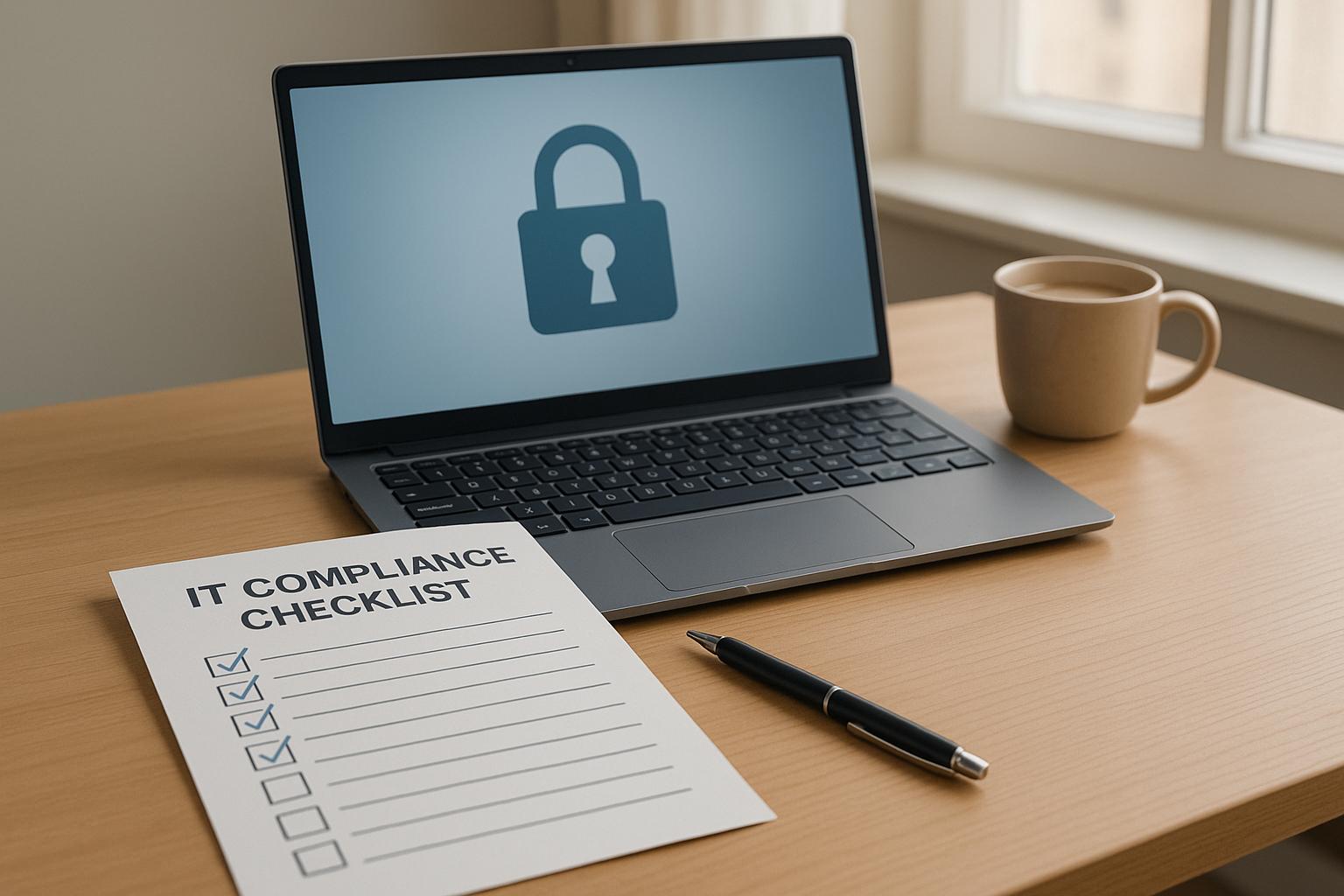IT compliance is about aligning your organization’s technology and data practices with legal and industry standards. It’s not just about avoiding fines; it’s about securing your systems, protecting sensitive data, and building trust with clients and stakeholders.
Here’s a quick rundown of the 10 essential IT compliance items every business needs:
- Access Controls and Identity Management: Restrict access to sensitive systems and data using tools like multi-factor authentication and role-based permissions.
- Data Security and Encryption: Encrypt data at rest and in transit with strong key management practices.
- Regular Risk Assessments: Identify vulnerabilities through scans, penetration tests, and continuous monitoring.
- Audit Trails and Logging: Maintain secure, tamper-proof logs for access and changes to critical data.
- Incident Response Planning: Have a clear plan for identifying, managing, and recovering from security breaches.
- Compliance Training and Awareness: Train employees regularly on compliance requirements and best practices.
- Vendor and Third-Party Risk Management: Evaluate and monitor external vendors to ensure they meet compliance standards.
- Data Privacy and PII Protection: Limit and secure Personally Identifiable Information (PII) to reduce risks.
- Compliance Tools and Solutions: Use specialized tools and services to manage compliance efficiently.
- Policy Documentation and Review: Keep policies and procedures up to date and organized for audits.
Why it matters: Strong compliance practices protect your business from legal trouble, data breaches, and reputational damage. Start with this checklist to identify gaps and prioritize improvements.
The Cyber Compliance Checklist Every SMB Must Master | Michael Senkbeil | Talk To Th3 Doc Ep. 106
IT Compliance Checklist: 10 Required Items
This checklist highlights ten critical controls to protect IT environments and ensure your organization meets regulatory standards. A solid IT compliance program doesn’t just safeguard your systems and data – it also helps you stay on the right side of the law. These ten items lay the groundwork for a reliable compliance strategy.
Access Controls and Identity Management
Managing who can access your systems and data is a key part of IT compliance. Identity and Access Management (IAM) ensures that only the right people can get into sensitive areas, combining tools and practices to verify identities and control permissions.
The first step is authentication – confirming a user’s identity before granting access. Modern methods like multi-factor authentication (MFA) or passwordless options provide stronger protection. Once authenticated, authorization determines what users can access and what actions they’re allowed to take. Role-Based Access Control (RBAC) or Attribute-Based Access Control (ABAC) can help assign permissions based on roles or user attributes.
Following the principle of least privilege is crucial. This means users only get access to what they need for their job, reducing risks if an account is compromised. Privileged Access Management (PAM) adds another layer of control for users with elevated permissions by using features like just-in-time provisioning and session recording.
Centralized directory services like Active Directory, LDAP, or Azure AD simplify managing user identities and permissions. Additionally, automating user lifecycle management – handling access changes when employees join, switch roles, or leave – helps minimize errors and keeps permissions up to date.
Data Security and Encryption
Encryption is a must for protecting sensitive data and staying compliant. Make sure your data is encrypted both when it’s stored and when it’s being transmitted. Use protocols like HTTPS, TLS, or VPNs for secure communication.
Strong encryption hinges on effective key management. This includes securely generating, storing, rotating, and revoking encryption keys. Data classification also plays a big role here – categorizing information helps you apply the right level of encryption to different types of data. Regular reviews and assessments can uncover potential vulnerabilities that may need attention.
Regular Risk Assessments
Frequent risk assessments are essential to spot and address vulnerabilities in your systems. Use tools like vulnerability scans and schedule annual penetration tests to identify weak points.
Documenting these assessments, along with the risks, their potential impact, and your planned responses, not only prepares you for audits but also helps fine-tune your security measures. Continuous monitoring through tools like real-time threat detection and Security Information and Event Management (SIEM) systems keeps your organization ahead of potential threats. Detailed logs are also a key part of compliance and incident investigations.
Audit Trails and Logging
Detailed logging is vital for compliance and security investigations. Your system access logs should capture key information, including login attempts (both successful and failed), privilege escalations, and critical administrative actions.
Make sure you’re logging access to sensitive data and tracking any changes made. Retain logs according to regulatory requirements, ensuring they’re secure, tamper-proof, and accessible for audits. Automated log analysis can help you turn raw data into actionable insights. A strong incident response plan is your next line of defense.
Incident Response Planning
A well-documented incident response plan is critical for handling security breaches and compliance issues. The plan should outline steps for identifying, containing, and recovering from incidents. Define incident classifications and assign specific roles to team members for efficient management.
Since notification requirements vary by regulation, include clear procedures and templates for timely reporting. Post-incident reviews and recovery processes will help refine your plan and strengthen overall security. Don’t forget to train your team on compliance responsibilities.
Compliance Training and Awareness
Compliance training should be part of your onboarding process, with annual refreshers to keep everyone updated. Tailor training to specific roles so employees understand the compliance challenges unique to their department.
Simulated exercises, like phishing tests, can reinforce security awareness and pinpoint areas where additional training is needed. Beyond your internal team, compliance oversight should extend to your vendors and partners.
Vendor and Third-Party Risk Management
As organizations increasingly rely on external vendors, managing third-party risks has become a priority. Conduct thorough due diligence and ensure contracts clearly outline security, data protection, and termination protocols.
Ongoing monitoring of vendor performance helps maintain compliance standards throughout the relationship. Finally, ensure personal data is handled responsibly.
Data Privacy and PII Protection
Protecting Personally Identifiable Information (PII) is a cornerstone of compliance. Limit the collection of PII to only what’s necessary, and regularly review your practices for storing, processing, and disposing of this data. Taking these steps minimizes risks and keeps sensitive information secure.
Compliance Tools and Solutions
Equifier builds on essential compliance controls by offering solutions that help organizations tackle the challenges of meeting strict IT standards. Many businesses face hurdles like limited resources or a lack of in-house expertise, making it tough to stay compliant. Equifier’s services are designed to fill these gaps, ensuring the right tools and skilled teams are in place to maintain compliance over time.
The company provides Cyber Security, Recruiting & Staffing, and IT Consulting services. These offerings include expert risk assessments, customized compliance strategies, and streamlined IT infrastructure to support secure digital transformation efforts.
These solutions have already shown their value, helping major industry leaders navigate complex compliance issues effectively.
As technology continues to advance, Equifier is expanding its cybersecurity and IT consulting capabilities, emphasizing that compliance isn’t just a one-time task – it’s an ongoing strategic effort. Their specialized tools and services support strong policy documentation and regular internal audits, ensuring organizations stay ahead in the compliance game.
sbb-itb-05efa2a
Policy Documentation and Review
Maintaining up-to-date IT compliance documentation is essential for demonstrating alignment with legal standards and regulatory requirements. Gather all records, policies, procedures, and training materials into a single, well-organized system. A centralized approach not only simplifies management but also ensures clarity and efficiency in maintaining compliance. Regularly reviewing and updating these documents is equally important, as it helps you stay aligned with evolving regulations. This proactive approach works hand-in-hand with your audit processes and incident response plans, creating a more robust compliance framework.
Conclusion
Using an IT compliance checklist is a smart way to shield your organization from costly fines, security breaches, and operational disruptions. The ten essential items we’ve outlined provide a strong starting point for building a compliance program that safeguards your technology systems and protects your business’s reputation.
Key elements like access controls, data encryption, incident response planning, and accessibility compliance all work together to create a proactive security framework. This approach not only meets regulatory standards but also strengthens your defenses against potential threats.
IT compliance isn’t a one-and-done task – it’s an ongoing process. Regular risk assessments, continuous monitoring, and thorough documentation ensure your compliance efforts stay in step with changing regulations. This consistent focus not only helps you meet legal requirements but also builds long-term resilience for your business.
For those looking to streamline their compliance efforts, partnering with Equifier can make a big difference. With services like expert risk assessments, tailored compliance solutions, and managed security services, Equifier helps businesses navigate complex regulations while optimizing their IT systems for future growth.
Here’s a word from Equifier:
"Secure your business with expert risk assessments, compliance solutions, and managed security services." – Equifier
Whether you need experienced IT professionals to oversee compliance initiatives, cybersecurity expertise to strengthen your defenses, or strategic guidance to optimize your IT infrastructure, having the right support is crucial. Investing in IT compliance today can save your organization from far more expensive consequences down the road, such as hefty regulatory fines or the loss of customer trust.
Start by using this checklist to identify your organization’s most pressing compliance gaps. From there, build a program that evolves alongside your business needs. Taking action now will pay off in the long run.
FAQs
How does using an IT compliance checklist strengthen data security and build client trust?
Using an IT compliance checklist is a smart way to bolster data security. By ensuring your organization adheres to essential security protocols, it minimizes the chances of breaches and helps protect sensitive information. It also provides a systematic way to address regulatory requirements and adopt best practices, creating a clear framework for managing IT risks.
Beyond security, it plays a key role in building client trust. When you show clients that you’re committed to protecting their data and meeting legal and ethical standards, it sends a strong message of accountability. This kind of transparency not only strengthens your reputation but also builds lasting confidence in your services.
What are the best practices for conducting regular risk assessments to support IT compliance?
To conduct risk assessments that genuinely support IT compliance, it’s essential to establish a regular schedule for reviews. Whether you choose quarterly or biannual assessments, consistency is key. Make sure to document all findings in detail – this creates a reliable record and promotes accountability.
Use the insights from these assessments to strengthen your compliance strategy. Focus on addressing the most critical risks first, monitor your progress, and adapt to any changes in regulations. Collaboration is crucial here – working closely with teams like IT and HR ensures a well-rounded approach. By keeping your risk management practices up-to-date, your organization will stay aligned with compliance standards and ready for any shifts in requirements.
Why is managing vendor and third-party risks essential for IT compliance, and how can organizations stay on top of these relationships?
Managing risks associated with vendors and third-party partners is a critical aspect of IT compliance. These external relationships can expose your organization to potential threats like data breaches or supply chain attacks, which could jeopardize both security and compliance efforts. Keeping a close eye on these risks is key to protecting sensitive data and maintaining stakeholder confidence.
To stay ahead, organizations should focus on a few key strategies: conducting ongoing risk assessments, setting clear standards for performance and compliance, and ensuring real-time monitoring of vendor activities. By taking this proactive stance, you can catch potential issues early and address them quickly, helping to secure your IT environment effectively.









